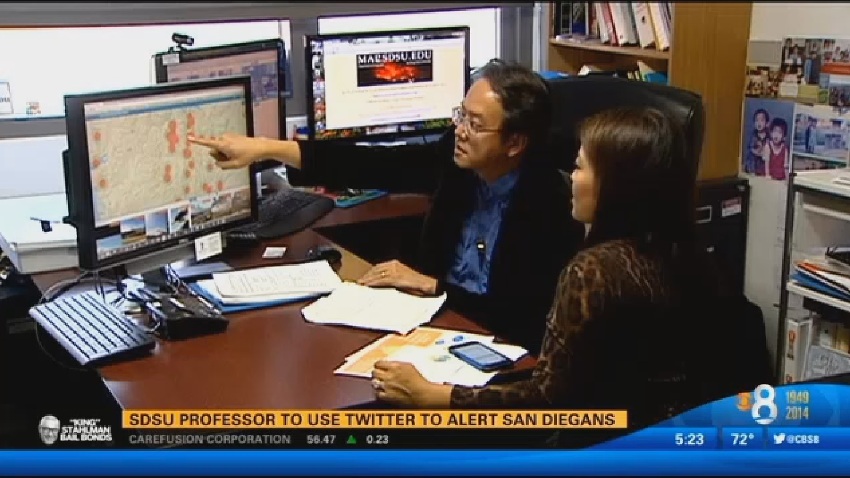- Oct. 15, 2014, SDSU Professor Selecting 'Tweeters' To Spread Emergency Messages
- Oct. 20, 2014, SDSU professor to use Twitter to alert San Diegans
- Oct. 14, 2014, SDSU, county want warnings to go viral
- Oct. 13, 2014, Going Viral with Emergency Warnings
- Oct. 13, 2014, SDSU looks for influential ‘tweeters’ to spread county’s emergency messages
- Oct. 13, 2014, San Diego's influential Twitter users to spread emergency messages
- Oct. 14, 2014, Twitter Inc (TWTR)’s Emergency Notification System Will Help Police in San Diego County: Ming Hsiang Tsou
- Jan. 31, 2014, ABC10News – San Diego, ‘SDSU researcher: Using Twitter to track the flu could save lives’
- Dec. 12, 2013, Health24, ‘Social media will help to monitor disease outbreaks’
- Dec. 03, 2013, U ~ T San Diego, ‘Researcher to Test If Twitter Can Help Spot Flu Trends’
- Nov. 21, 2013, HuffPost, ‘Twittter Could Tell You Where Flu is Ramping Up, Study Suggests’
- Nov. 19, ScienceDaily, ‘Hashtag Health’
- Nov. 15, 2013, KPBS, ‘Using Twitter To Predict Elections—Or The Flu’
- Nov. 09, 2013, News Center, ‘Hashtag Health’
- Nov. 08, 2013, KPBS Interview: Social Media Analysis and the San Diego Mayor's Race.
- Nov. 09, 2013, News Center, ‘Hashtag Health’
- Nov. 09, 2013, News Center, ‘Hashtag Health’
- Sep. 2011 360 Magazine, ‘Mapping Cyberspace’
- Nov. 11, 2011 News SDSU Mapping Cyberspace
- Nov. 22, 2005 "SDSU Professor Maps the Future", By MOLLY BETTIGA, Voice Contributing Writer
- Nov. 30, 2005, KPBS, The highlights of CESAR lab and the visualization of San Diego Wildfire 2003 in Google Earth Demo. at San Diego State University.
- June 20, 2002, KPBS, The introduction of GIS research with Mobile devices, GPS, and remote sensing technologies at the Department of Geography, San Diego State University.
MEWS & MEDIA

Ming-Hsiang Tsou, an SDSU geography professor, is compiling a list of 1,000 influential Twitter accounts based in San Diego, so emergency messages about evacuations, road closures and the like can be spread faster or targeted more closely to certain locations (source:KPBS).

SAN DIEGO (CBS 8) - Have you ever wondered why certain tweets or Facebook posts go viral, and others get no interest whatsoever? A research team at San Diego State University has just received a $1 million grant from the National Science Foundation to answer that question, and then use that information to help protect San Diegans (source:CBS8News-San Diego).

In times of disasters, many people turn to social media instead of traditional outlets to get the latest information. Under a partnership between San Diego State University and the county, officials will enlist 1,000 Twitter users in San Diego County as volunteers with the goal of making emergency warnings go viral (source:UT-San Diego).

San Diego County is partnering with San Diego State University to develop a new social media–based platform for disseminating emergency warnings to San Diego citizens (source:SDSU Newscenter).
SAN DIEGO – Official emergency messages for San Diego County might be spread in the future by the most influential “tweeters,” San Diego State University announced Monday (source:FOX5-San Diego).
SAN DIEGO (CNS) - Official emergency messages from the county of San Diego in the future might be spread by the region's most influential "tweeters," San Diego State University announced Monday (sorce:KUSI).
In a recent development to facilitate the general public with social media based emergency messaging systems, San Diego County and San Diego State University have partnered under the leadership of Ming-Hsiang Tsou, an SDSU geography professor to start a system in the county for disseminating emergency messages from Twitter (source:Tech Insider).
Mapping cyberspace is one of many ways SDSU faculty are leading innovation and discovery, a key initiative of the Campaign for SDSU. With a unique focus on the teacher-scholar model, SDSU attracts researchers interested in solving the world’s most pressing problems, while showing students how to provide future solutions. Learn more about how SDSU leads innovation and discovery, and how you can help.
A $1.3 million grant from the National Science Foundation will help SDSU researchers create new ways to analyze the spread of information and ideas on the Internet. The multidisciplinary cyber-infrastructure innovation project will map cyberspace by tracking the flow of information and monitoring its movement on the Internet.
























